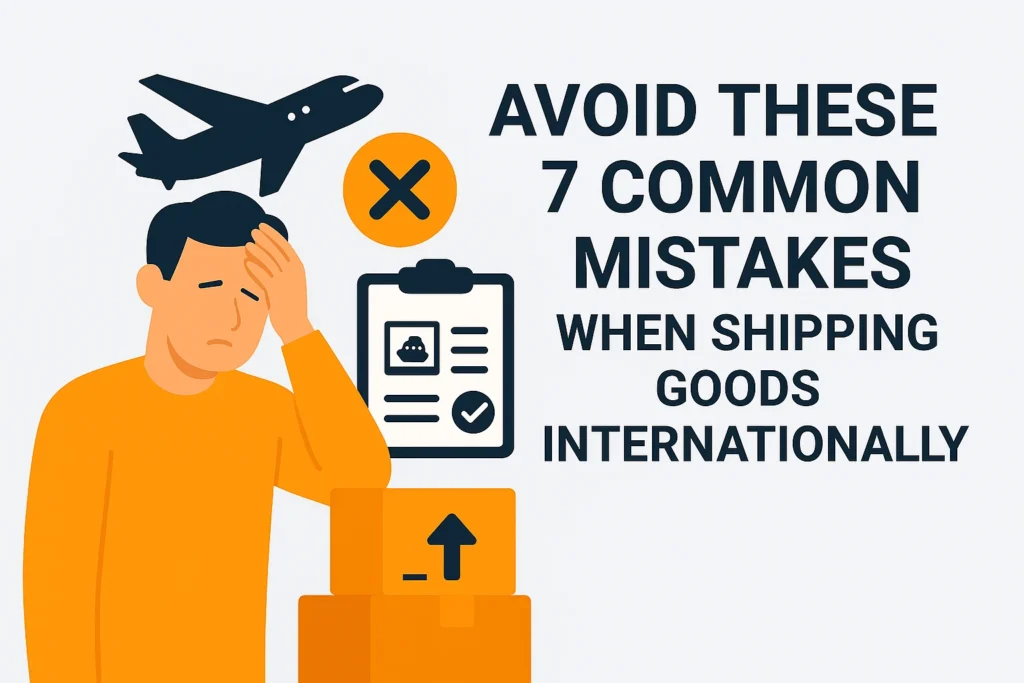International shipping can open the door to global growth, but it’s also where many businesses lose money, delay deliveries, and frustrate customers. Whether you’re a first-time shipper or scaling up to new markets, understanding the most common pitfalls can save time, money, and headaches. Here’s a practical guide to seven key mistakes you should avoid, plus how to get it right.
1. Neglecting Destination Country Regulations
One of the biggest mistakes sellers make is assuming that international shipping is simply domestic shipping with longer distances. But customs laws, import restrictions, and documentation requirements vary dramatically from country to country. What’s allowed in the UAE may be prohibited in Saudi Arabia or require extra permits in Europe.
Before shipping, research the import rules for each country you’re targeting. Failure to comply can result in fines, returned goods, or shipment confiscation. Partnering with a freight forwarder or customs clearance service can help ensure you’re on the right track.
2. Underestimating the Total Cost of Shipping
Many sellers budget for shipping based only on the carrier’s freight rate. But that’s just the beginning. Duties, taxes, insurance, handling fees, packaging costs, and unexpected surcharges all add up and can dramatically affect your profit margins.
It’s important to calculate the true “landed cost” of a product, the total price of delivering goods to a customer’s door. If you don’t, you might end up charging too little and absorbing costs that should’ve been passed to the buyer.
3. Incomplete or Incorrect Documentation
Incorrect paperwork is one of the most common reasons international shipments are delayed or held at customs. Each country has specific documents that must be included with every shipment. These typically include:
- A commercial invoice with product value, description, and HS codes
- A packing list with weights, dimensions, and item breakdown
- A bill of lading or airway bill
- Certificates of origin or import permits if required
Errors in any of these documents can lead to shipment rejection or additional scrutiny. Make sure every document is accurate, consistent, and reflects what’s in the box.
4. Poor Packaging or Incorrect Labeling
Packaging that doesn’t meet international standards can lead to damaged goods, customs delays, or extra charges. Fragile or valuable products need extra protection and labeling. Additionally, mislabeling can result in customs fines or denied entry altogether.
Always use sturdy boxes, secure sealing, and protective fillers. Ensure labels include recipient details, product description, origin country, and any required warning symbols or language. It’s also smart to include both English and the local language if possible.
5. Miscommunication Around Duties and Taxes
One frequent misunderstanding is who pays customs duties and taxes, the seller or the customer. This is usually determined by your shipping terms, such as DDP (Delivered Duty Paid) or DAP (Delivered at Place).
If you don’t clearly communicate this in advance, your customer might get hit with an unexpected customs bill upon delivery. That can lead to complaints, negative reviews, or even returns. Clarify your pricing and incoterms at checkout, and make sure your logistics provider knows which party is responsible for what.
6. Lack of Tracking and Customer Communication
Today’s online shoppers expect visibility. If customers don’t know where their package is or what to expect, they’ll quickly become frustrated. Shipping internationally can sometimes result in longer delivery times, and without updates, buyers may assume their order is lost.
Use a courier that offers tracking, and provide that tracking number as soon as the shipment leaves. Even better, set up automated email or SMS updates. Proactive communication during delays can go a long way toward maintaining trust.
7. Ignoring Returns Policies and Currency Preferences
If you don’t offer returns for international orders, or make your return process unclear, you may lose potential customers. Buyers want assurance that they can send something back if it’s the wrong size, arrives damaged, or doesn’t meet expectations.
Also, consider the customer experience when it comes to currency. Forcing buyers to pay in a foreign currency can lead to abandoned carts. Offer local currency payments and clearly state your refund and exchange policies.
Why These Mistakes Matter
Avoiding these mistakes isn’t just about efficiency, it’s about building a long-term reputation. Poor documentation or unclear duties can slow down customs. Weak packaging leads to damage. Unclear pricing damages trust. Every misstep costs time, money, and your customer’s confidence.
By mastering the logistics and putting strong systems in place, you can transform international shipping from a risk into a competitive edge.
Work with a Shipping Partner Who Knows the Rules
At SamVertex, we help e-commerce sellers across the UAE handle their international shipments with confidence. From proper documentation and packaging to customs clearance and last-mile tracking, we’ve got your logistics covered.
Whether you’re shipping to the Gulf region, Asia, or Europe, we streamline your entire process so you can focus on growing your business, not fixing shipping errors.
📦 Need help with international freight? Contact us today for a free consultation.
مراجع
- DHL: Common international shipping mistakes and tips for e-commerce sellers
- FedEx: Avoiding customs delays and documentation errors
- Maersk: Top declaration and shipping pitfalls
- ShipGlobal: International freight and returns handling best practices
- DCL Logistics: Mistakes that cost e-commerce sellers during cross-border fulfillment

